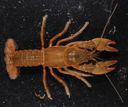Cambaridae
Cambaridae
Classification
- Phylum: Arthropoda
- Subphylum: Crustacea
- Class: Malacostraca
- Superorder: Eucarida
- Order: Decapoda
- Infraorder: Astacidea
- Superfamily: Astacoidea
- Family: Cambaridae
Pronunciation
How to pronounce Cambaridae: /kæmˈbærɪdi/
These audio files are automatically generated. While they are not always 100% accurate, they are a good starting point.
Images






Summary
The Cambaridae are the largest of the four families of freshwater crayfish, with over 400 species and the world's greatest diversity of crayfish species found in southeastern North America. Most species are concentrated in this region, but they can be found in various other parts of North America and eastern Asia.
Distribution
The Cambaridae are primarily native to the United States east of the Great Divide and Mexico, with fewer species found in Canada, Guatemala, and Honduras. Three species are found on the island of Cuba. The genus Cambaroides is restricted to eastern Asia.
Conservation Status
Many species have tiny ranges and are seriously threatened; a few are already extinct.
Evolution
A 2006 molecular study suggested that the family Cambaridae may be paraphyletic, with the family Astacidae nested within it. The status of the genus Cambaroides remains unclear. The oldest fossils of the family are known from the Late Jurassic Morrison Formation of western North America.
Tags
- crayfish
- Cambaridae
- freshwater
- taxonomy